
When the 2009 SVT Ford Raptor came on the scene it was a game changer. Although it has since ditched the Special Vehicle Team tag, the Raptor was the first performance off-road truck boasting true race-inspired, aftermarket-level suspension. Best of all, it could be bought from the same lot youíd buy a traditional F-150 and it was backed with a factory warranty. Fordís Raptor was a big gamble, but itís one that has been paying off ever since.
The second-generation Raptor has big shoes to fill, and at its core, the 2017 model is the same truck as when it was introduced back in 2009. But Ford is making another gamble with the new Raptor by ditching the 6.2L V8 in favor of a V6 EcoBoost engine. The change was greeted with some groans and skepticism, but that tone changed a bit when Ford announced that no ordinary EcoBoost would power the second-gen Raptor Ė nope, this high-output engine actually produces 76 more ft.-lbs. of torque and 39 more horsepower than the outgoing 6.2L V8. The twin-turbo HO EcoBoost also offers a 23 percent improvement in EPA combined fuel economy (16 mpg compared to 13 mpg).
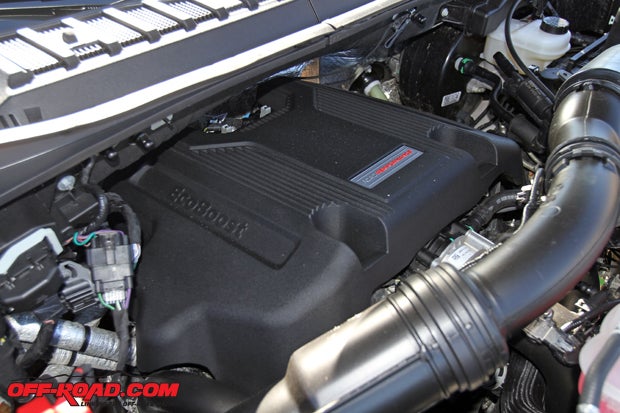
Still, the question remains: does the new HO EcoBoost measure up to the outgoing V8 and keep the Raptor at the top of the heap? Letís see.
Get the Flash Player to see this player. |
MORE OFF-ROAD CAPABLE
The new engine gets a lot of the attention on the second-generation 2017 Raptor (as it should), but thereís plenty more to talk about on the truck. The Raptor is an awesome all-around performance vehicle, but itís the suspension that deserves the lionís share of credit for the Raptorís off-road chops.

A look back at our driving impression of that first 2009 Raptor reminded us that Ford had the right idea from the get-go. Ford SVT chief nameplate engineer Jamal Hameedi made that clear at the time. ďBuilding a high-performance off-road truck is not about the horsepower Ė itís about the suspension Ė and the F-150 SVT Raptor doesnít disappoint,Ē Hameedi said. ďItís well beyond what SVT has ever done with one of our vehicles.Ē
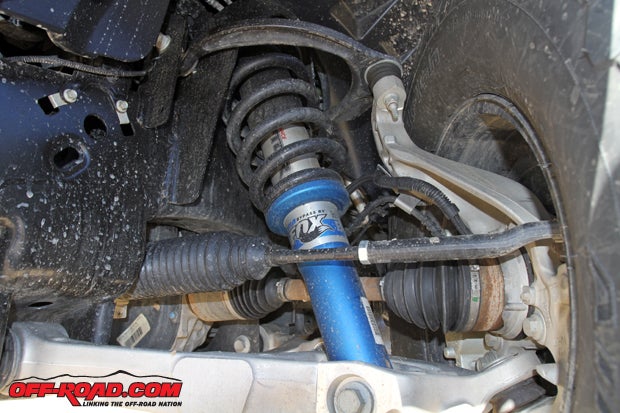
The first-gen Raptor was fitted with impressive 2.5-inch-diamter Fox shocks, but for the new Raptor Ford is employing larger-diameter 3-inch Fox shocks. This suspension upgrade offers a notable improvement in the truckís off-road prowess, as the nine-stage internal bypass front coilovers offer 13 inches of suspension travel, while the rear boasts 13.9 inches of travel. Thatís an increase of almost 2 inches of travel front and rear, or a 15 percent increase in overall suspension travel. The new shocks also offer 44 percent more volume to help dissipate heat.
Like the Super Duty did in 2017, the SuperCab and SuperCrew Raptors also get an aluminum alloy body to help shed weight to improve its horsepower-to-weight ratio by shedding as much as 500 pounds. Ford says it employs more high-strength steel in the frame and also on the shock mounts than the previous version. The Raptorís stance is 6 inches wider than a standard F-150, which aids in improved off-road stability and helps gives the truck its aggressive look. The full-four-door SuperCrew has a 145-inch wheelbase that is 12 inches longer than the SuperCab model.

Ford still sports exclusive BFGoodrich rubber on the Raptor, but this time it swaps out the T/A KO for a custom-sized T/A KO2s that are fitted on 17-inch beadlock-capable wheels. The 2017 Raptor has an increased ride height compared to the previous generation, and its other off-road stats are impressive for those who actually plan to wheel it: 30-degree approach angle, 22-degree breakover and 23-degree departure angle.

Ford pairs its new 10-speed automatic transmission to the new high-output EcoBoost engine. The new Raptor still features on-the-fly shifting with its wheel-mounted paddle shifters, which are a blast to use both on the highway and on the trail. Ford also employs a new transfer case on the 2017 Raptor that actually merges all-wheel-drive and 4WD capability using a clutch-based torque-on-demand system that is designed to apply torque between the front and rear wheels, but the Raptor still retains a mechanical lock for 4x4 high and low. A new Terrain Management System is found on the truck, offering six different settings (Normal, Weather, Mud/Sand, Baja, Rock Crawl) to dial in the ideal traction for the terrain.
The HO EcoBoost engine itself owes its performance increase over the standard F-150 EcoBoost V6 to a number of factors, including twin turbochargers with higher boost and that are fitted with electric actuated waste gates for added control over said boost. A larger intercooler and piston-cooling oil jets help keep temps down under the hood. The HO EcoBoost also gets new port and direct fuel injection systems for added efficiency. A new dual exhaust system helps efficiently process the spent exhaust from the dual-turbo engine.

Driving Impression
Itís been quite some time since the first Raptor was unveiled, and weíre happy to report Ford has used the time wisely to improve the second-generation model significantly. To address the elephant in the room, yes, the HO EcoBoost feels different than the V8. Thereís a little less bottom-end oomph and not quite the same depth in the exhaust note. But make no mistake: The HO EcoBoost is a powerful and impressive engine. When the turbos spool up and the engine gets on boost the truck pulls very hard. It might take a moment to get used to, but trust us, after a few minutes behind the wheel no one will mistake this engine for anything less than the performance monster it is. We also have to commend Ford on doing a great job with the timing of its new 10-speed, because we felt like it clicked through the gears flawlessly in every situation.
The suspension upgrades on the new Raptor is another sign that Ford gets it. It would have been perfectly acceptable to return with an upgraded version of the 2.5-inch-diameter shocks from the first-gen Raptor; instead, the new truck gets larger 3-inch-diameter shocks that not only improve the available travel, they also address one of the first upgrades Raptor owners would make on the first-gen truck Ė upgrade to beefier 3-inch shocks. The Fox suspension allows the truck to shine in everything from whooped-out open desert roads to rock-covered trails. The Raptor tackles desert terrain very much like a pre-runner race truck would, floating over whoops and ruts with supreme confidence even at a high rate of speed. Thatís just it: the Raptor is capable of driving over rugged desert terrain at speeds that honestly no other production truck can. The internal-bypass Fox shocks do a great job of soaking up slow-speed obstacles while also feeling right at home powering through open desert at speeds in excess of 70 mph.

The Terrain Management System on the Raptor works well, and off of the highway we most often used the rock mode for tricky, slow-speed trails and used Baja mode when driving through the desert. Baja mode tones down the input from the stability control system and tweaks the shift pattern of the 10-speed to keep the engine RPM revving higher for that on-demand power, and itís the setting we used most during testing in the Southern California desert.
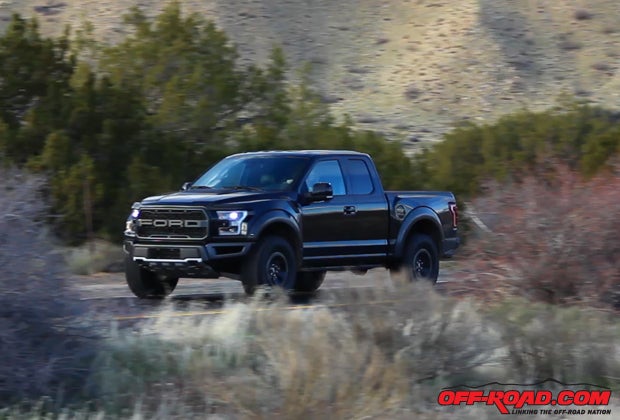
In spite of its off-road savvy, the Raptor feels great on the highway. Itís fun to drive on windy roads, and itís a blast to punch the throttle and let the turbos fire to life on the open highway. As expected, the suspension is a little softer in the turns than a traditional half-ton, and thatís simply the compromise for its off-road-tuned suspension. In no way is it a knock on the truck, however Ė it feels comfortable and confident to drive even in cramped parking lots.
The off-road-tuned suspension comes with some limitations for the Raptorís trailering and payload capacities. The SuperCab model has a 6,000-pound max trailer rating while the SuperCrew is set at 8,000 pounds, and when it comes to payload the SuperCab is rated at 1,000 pounds and the SuperCrew at 1,200. These towing and payload capacities are not horribly impressive for a half-ton truck (in fact, the payload capacities are the lowest of any current Ford truck available). We did have the opportunity to tow with the truck, pulling a 4,000-pound test trailer for our SuperCab test model. Our Raptor got the job done, but the off-road suspension does feels softer with a trailer attached than a traditional half-ton, so it doesnít make for the ideal tow vehicle for long-distance trips.
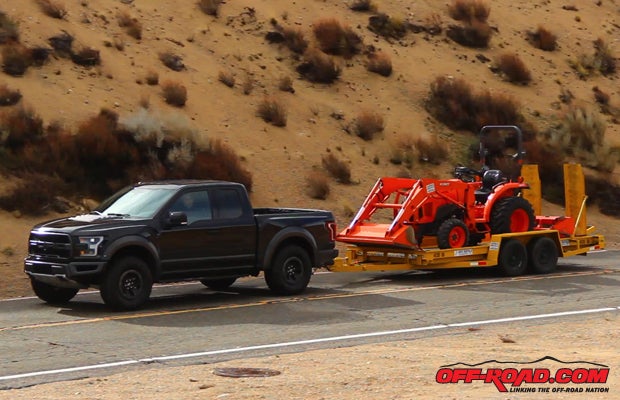
Ford does a great job of connecting the driver with the machine, and part of the confidence this truck exudes may be due to sporty feel of the cabin. From the body-hugging leather front seats, leather-wrapped steering wheel and the billet paddle shifters, the Raptor just feels like a performance machine that invites the driver to go!
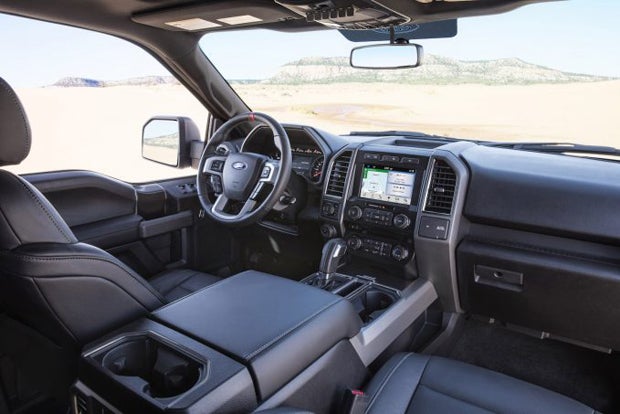
Sync3 is used in the Raptorís new infotainment unit, which offers voice-activated function and incorporates Apple CarPlay and Android Auto. At the center of the dash is a new 8-inch touchscreen to control navigation, entertainment features and smart phone integration. Our only real gripe with the Raptorís interior is the same weíve voiced before Ė it feels a little too cluttered with buttons and controls, especially the buttons on the steering wheel. One of the coolest features in the new Raptor has to be the 360-view camera, which uses small cameras to provide a view of the terrain around the rig, making towing, trailer connection and tricky off-road navigation a little more manageable. Auxiliary switches are mounted above the driver for easy access to power add-on equipment like lighting, compressors or other tools.

Second-Gen Success
On paper, we werenít sure Fordís move to a V6 on the new Raptor was a good one, but after driving the truck itís clear the 2017 Raptor still has that same soul as the original. With improved suspension, increased overall performance and more efficiency to boot, the new Raptor is a turnkey package that provides everything an off-road truck enthusiast needs.
MORE FORD STORIES
2019 Ford Ranger Prototype Photos


 Your Privacy Choices
Your Privacy Choices